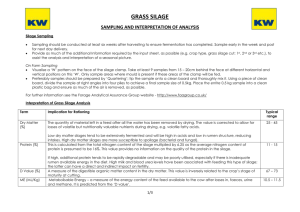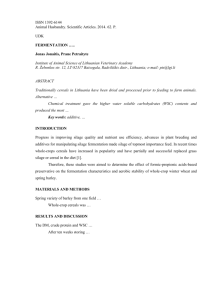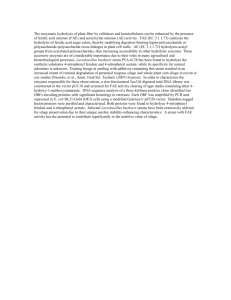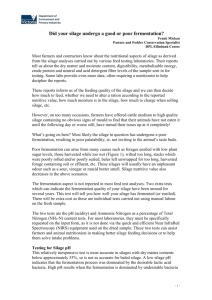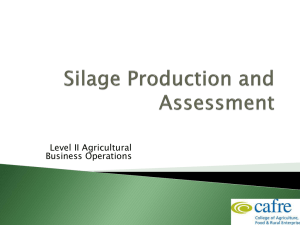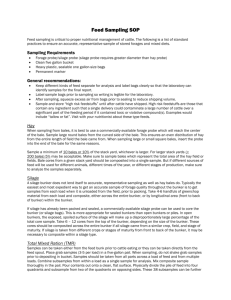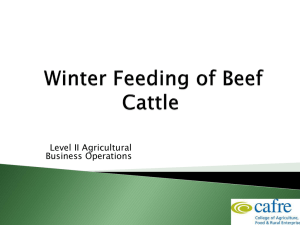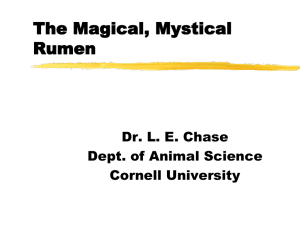whole crop silage sampling and interpretation of analysis
advertisement
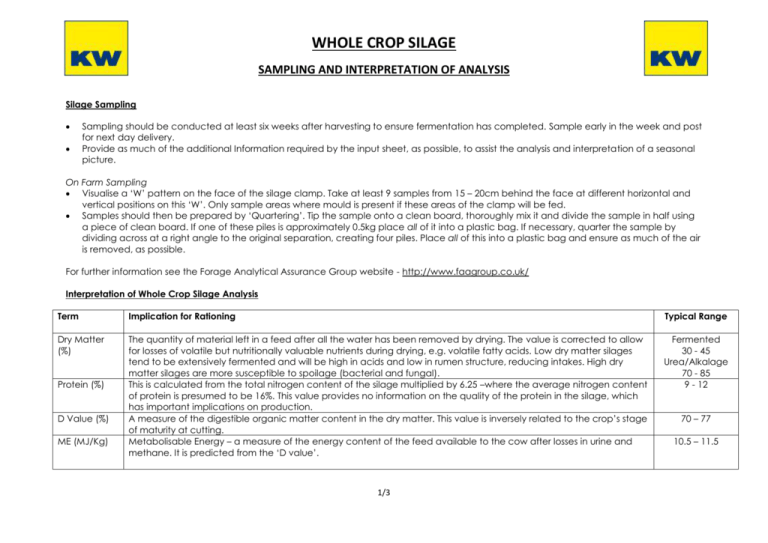
WHOLE CROP SILAGE SAMPLING AND INTERPRETATION OF ANALYSIS Silage Sampling Sampling should be conducted at least six weeks after harvesting to ensure fermentation has completed. Sample early in the week and post for next day delivery. Provide as much of the additional Information required by the input sheet, as possible, to assist the analysis and interpretation of a seasonal picture. On Farm Sampling Visualise a ‘W’ pattern on the face of the silage clamp. Take at least 9 samples from 15 – 20cm behind the face at different horizontal and vertical positions on this ‘W’. Only sample areas where mould is present if these areas of the clamp will be fed. Samples should then be prepared by ‘Quartering’. Tip the sample onto a clean board, thoroughly mix it and divide the sample in half using a piece of clean board. If one of these piles is approximately 0.5kg place all of it into a plastic bag. If necessary, quarter the sample by dividing across at a right angle to the original separation, creating four piles. Place all of this into a plastic bag and ensure as much of the air is removed, as possible. For further information see the Forage Analytical Assurance Group website - http://www.faagroup.co.uk/ Interpretation of Whole Crop Silage Analysis Term Implication for Rationing Typical Range Dry Matter (%) The quantity of material left in a feed after all the water has been removed by drying. The value is corrected to allow for losses of volatile but nutritionally valuable nutrients during drying, e.g. volatile fatty acids. Low dry matter silages tend to be extensively fermented and will be high in acids and low in rumen structure, reducing intakes. High dry matter silages are more susceptible to spoilage (bacterial and fungal). This is calculated from the total nitrogen content of the silage multiplied by 6.25 –where the average nitrogen content of protein is presumed to be 16%. This value provides no information on the quality of the protein in the silage, which has important implications on production. A measure of the digestible organic matter content in the dry matter. This value is inversely related to the crop’s stage of maturity at cutting. Metabolisable Energy – a measure of the energy content of the feed available to the cow after losses in urine and methane. It is predicted from the ‘D value’. Fermented 30 - 45 Urea/Alkalage 70 - 85 9 - 12 Protein (%) D Value (%) ME (MJ/Kg) 1/3 70 – 77 10.5 – 11.5 WHOLE CROP SILAGE SAMPLING AND INTERPRETATION OF ANALYSIS pH NH3-N of Total N (%) Ash (%) Starch (%) NDF (%) MPB (g/kg) MPN (g/kg) ‘sN’ ‘aN’ ‘bN’ ‘cN’ MPE (g/kg) ‘sDM’ ‘aDM’ ‘bDM’ ‘cDM’ Intake (g/kg ML) A measure of the acidity or alkalinity of the silage; pH < 7 = Acidic, pH 7 = Neutral, pH > 7 = Alkaline. When feeding out, products such as ‘Regulator Feed Out’ can be incorporated to reduce further heating and mycotoxin binders e.g. Ultrasorb, can be used to minimise the mycotoxin challenge. With an alkaline pH, Alkalage can be used to balance the acidity of silages and act as a rumen buffer to improve stability and function. Ammonia is by-product of protein breakdown. 4 – 4.2 A measure of the total mineral content. Starch is the primary energy source of whole crop silage. The Neutral Detergent Fibre value indicates the total fibre content of the plant and includes the hemi-cellulose, cellulose and lignin residues. High NDF levels are associated with mature crops at cutting. Metabolisable Protein from Bypass Protein (also called DUP). Protein which is protected from degradation in the rumen. This fraction is important when rationing high yielding dairy cows as the rumens supply of metabolisable protein for milk production is limited. The MPB content of the ration should be increased to reflect greater milk yields using products such as SoyPass®. Metabolisable Protein supply from the silage where rumen nitrogen (protein) is limiting. It is typically greater than MPE as rumen energy is usually the limiting factor in a ration. High levels of MPN in the ration can, indirectly, negatively influence fertility. Rumen degradable fractions; these values measure the instantly soluble (sN), rapidly degradable (aN) and potentially degradable (bN) protein fractions of the silage. The rate of fermentation of the potentially degradable fraction (bN) is described by ‘cN’. The ‘Metabolisable Protein supply where rumen energy is limiting’. The energy for the rumen microbes is provided by the sugar, starch and fibre components of the silage and tends to be the limiting factor in rationing. Rumen degradable fractions; these values measure the instantly soluble (sDM), rapidly fermentable (aDM) and potentially fermentable (bDM) dry matter of the silage. The rate of fermentation of the potentially fermentable fraction (bDM) is described by ‘cDM’. A relative indication of how much silage a standardised cow will eat by choice. It is influenced by a mix of dry matter, crude protein, digestibility, fibre fractions, VFAs and ammonia N concentration of the silage; typically, higher intakes are indicative of higher quality silages. Dry matter, digestibility and protein are positively related to intake. The Feed into Milk ration program converts this value into specific intakes for the cow being rationed. 4–8 20 - 30 40 - 60 2/3 0–4 20 -30 50 - 70 N/A 75 - 90 N/A 100 - 120 WHOLE CROP SILAGE SAMPLING AND INTERPRETATION OF ANALYSIS Rumen Stability Value FiM PAL (meq/kg) An indication of how stable the rumen will be when fed the silage, it is calculated from the NDF and Potential Acid Load (PAL). Silage with low RVS’s values may reduce the pH of the rumen, leading to acidosis and reduced intakes. The Feed into Milk ration program considers this in conjunction with other ration components and cow details to predict the overall effect on rumen health. The Potential Acid Load represents the silage fermentation acids, those produced by the rumen micro-organisms during digestion and any other feed components e.g. amino acids. Rations containing a high PAL content will typically have a low RSV. 3/3 320 - 360 700 - 1000
